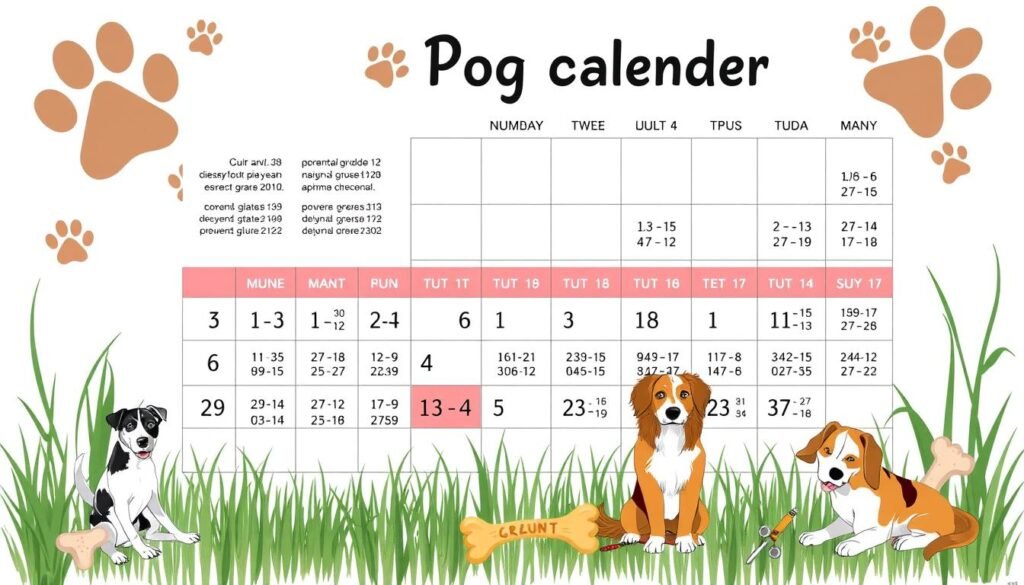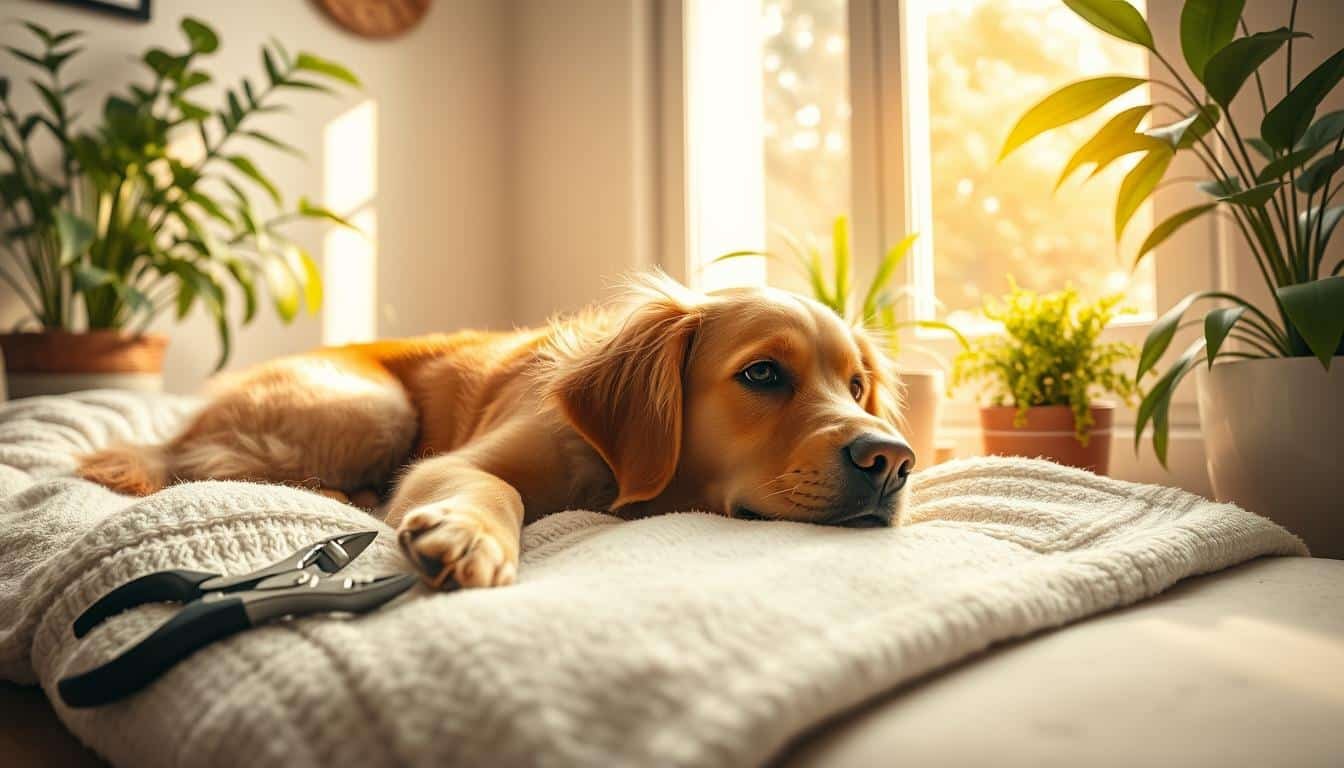Ever thought about your dog’s nails getting too long? Taking care of your dog’s nails is key to their health. But, many pet owners forget this important step. Knowing when to trim your dog’s nails is crucial for their comfort and health.
It’s important to trim your dog’s nails regularly to keep their paws healthy. It might seem hard, but adding nail care to your routine can prevent many problems. Overgrown nails can lead to joint pain and make walking hard.
Most dogs need their nails trimmed every week or two. But, how often depends on how active they are and where they walk. By keeping up with nail care, you help your dog stay happy, healthy, and comfortable.
Key Takeaways
- Regular nail trimming is essential for your dog’s health and comfort
- Most dogs need nail trims every 1-2 weeks
- Proper nail care prevents joint stress and walking difficulties
- Trimming frequency varies based on activity level and walking surfaces
- Starting nail care early helps dogs adjust to the process
Understanding the Importance of Nail Care for Dogs
Proper nail care is key for your dog’s health and happiness. Regular trimming stops many problems and keeps your pet joyful. Let’s look at why nail care is important and how to spot overgrown nails.
The Impact of Long Nails on Dog Health
Long nails can cause big issues for your dog. They can spread the toes and stress the ankle joints. This makes walking hard and uncomfortable for your pet.
In severe cases, long nails can curl into the paw pads. This causes pain and can lead to infections.
Benefits of Regular Nail Trimming
Short nails have many benefits:
- Improved posture and gait
- Reduced risk of nail splitting or cracking
- Better traction on various surfaces
- Decreased likelihood of nail bed infections
Regular trimming is a crucial dog nail maintenance tip. It shortens the quick, making future trims easier and less stressful for both you and your pet.
Signs Your Dog’s Nails Need Attention
Knowing when to trim your dog’s nails is vital. Look out for these signs of overgrown dog nails:
| Sign | Description |
|---|---|
| Clicking sounds | Nails tap loudly on hard floors |
| Visible curling | Nails curve towards paw pads |
| Altered gait | Dog walks with an unusual posture |
| Difficulty standing | Dog struggles to maintain balance |
By watching for these signs and following proper dog nail maintenance tips, you can avoid cracked nails. Regular nail care is vital for your dog’s health.
Factors Affecting Nail Growth in Dogs

Knowing what affects your dog’s nail growth is key for a good nail care plan. Many things influence how fast and how much your dog’s nails grow and wear down.
Surface Types and Their Influence
The surfaces your dog walks on every day affect their nail wear. Hard surfaces like concrete help file down nails naturally. But, soft surfaces like grass or carpet don’t do as much. Think about your dog’s environment when planning their nail care.
Activity Level and Nail Wear
Active dogs usually need less nail trimming. Walking on different terrains helps keep their nails filed naturally. But, less active dogs might need more nail care as part of their routine.
Diet and Nutritional Factors
A good diet full of nutrients is important for healthy nails. Foods with proteins, biotin, and omega-3 fatty acids help keep nails strong. Talk to your vet to make sure your dog’s diet supports nail health.
Medical Conditions Impacting Nail Growth
Some health problems can slow down or change nail growth. Issues like infections, auto-immune diseases, and tumors can affect nails. Regular vet visits can help catch and treat these problems early.
| Factor | Impact on Nail Growth | Nail Care Adjustment |
|---|---|---|
| Hard Surfaces | Increased wear | Less frequent trimming |
| Soft Surfaces | Minimal wear | More frequent trimming |
| High Activity | Natural filing | Longer intervals between trims |
| Low Activity | Faster growth | Shorter intervals between trims |
| Nutritional Deficiency | Weak nails | Diet adjustment, supplements |
How Often to Cut Dog’s Nails
It’s important to take care of your dog’s paws. How often you need to trim their nails depends on their lifestyle and how fast their nails grow. Most dogs need their nails trimmed every 1-2 weeks. Some might need it every 4 weeks.
One way to know if your dog needs a trim is to listen for a clicking sound when they walk. If you hear this, it’s time for a trim. Trimming their nails regularly keeps them short and makes future trims easier.
Puppies should start with weekly trims of just the tips. This helps them get used to the process. As they grow, you can adjust the schedule based on their needs.
- Check nails weekly
- Trim every 1-4 weeks, as needed
- Listen for clicking on hard floors
- Adjust frequency based on lifestyle and growth rate
Your dog’s activity level and where they walk also affect their nails. Dogs who walk on rough surfaces might need trims less often. By making nail care part of your routine, you’ll keep your dog comfortable and healthy.
Essential Tools and Techniques for Nail Trimming

Learning how to clip your dog’s nails safely is key to their health. We’ll look at the tools and methods used by pros to keep your dog happy and healthy.
Choosing the Right Nail Clippers
Picking the right nail clippers is the first step in nail care. There are many types of clippers made just for dogs, fitting different breeds and sizes.
- Scissor-style clippers: Ideal for small to medium dogs
- Guillotine-style clippers: Best for medium to large breeds
- Grinder tools: Suitable for smoothing rough edges
Proper Trimming Technique
To make nail trimming safe and stress-free, follow these steps:
- Hold your dog’s paw gently but firmly
- Identify the quick (blood vessel inside the nail)
- Trim small amounts at a 45-degree angle
- Reward your dog with treats and praise
Dealing with Dark Nails
Dark nails are tricky because you can’t see the quick. Here’s how to trim them:
- Cut tiny amounts at a time
- Look for a chalky white ring in the center
- Stop trimming when you see a small, dark dot in the center
| Nail Color | Visibility of Quick | Trimming Approach |
|---|---|---|
| Light | Visible (pink) | Cut 2mm away from quick |
| Dark | Not visible | Trim in small increments |
Remember, practice makes perfect. If you’re unsure, ask a professional dog groomer to teach you safe clipping techniques.
Overcoming Challenges in Nail Trimming
Nail trimming can be tricky for many pet owners. Fear of hurting your dog or dealing with a nervous pup can make the task daunting. Safe dog nail clipping techniques start with patience and positive reinforcement. Reward your dog for calm behavior during the process to build trust.
For anxious dogs, try gradual desensitization. Let your dog get used to the clippers without cutting. Touch their paws often to reduce sensitivity. If home trimming proves too difficult, professional dog nail grooming services are available. Many veterinary clinics and pet salons offer expert nail care.
Some dogs may prefer nail grinding to clipping. This method uses a rotary tool to file down the nails and can be less stressful. Whether you choose clipping or grinding, always prioritize your dog’s comfort. With practice and the right approach, nail care can become a smooth part of your pet care routine.








Interesting read, but does breed affect how often we should trim? My husky seems fine with longer nails. Anyone else noticed this?
Breed affects nail growth rate, not trimming frequency. Even huskies need regular nail care!
Not convinced. What if dogs naturally wear down their nails? Like wild wolves do! Is this just a ploy from the pet industry?
Wild wolves roam miles daily, unlike domestic dogs. Its about common sense, not industry ploys.
Interesting read. But I wonder, isnt it more natural to let a dogs nails wear down on their own?
Just read the article. But doesnt cutting dog nails frequently risk hurting them? What about using nail grinders instead of clippers?
Interesting read but ever considered dogs might actually prefer longer nails? Adds to their primal instinct, doesnt it? Just a thought.
Primal instinct? Perhaps, but long nails can cause discomfort or injury to dogs. Health over instinct.
Interesting read, but arent dogs in the wild managing just fine without nail trims? Maybe were overthinking this pet care thing?
Wild dogs wear down nails naturally, domestic ones cant. Pet care is crucial, not overthinking.
Interesting read, but isnt it natures job to keep dogs nails in check? Why interfere if theyre outdoor pets?